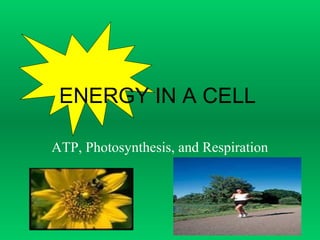Fredrickson photosynthesis
•Download as PPT, PDF•
0 likes•366 views
Cells obtain energy from ATP molecules, which get their energy by breaking off phosphate groups. Photosynthesis is how plants harness energy from sunlight to produce glucose and oxygen from carbon dioxide and water. The light reactions use sunlight to produce ATP and NADPH, and the Calvin cycle uses these to fix carbon from carbon dioxide into glucose. Respiration is how organisms extract energy from glucose to power their functions and produce ATP.
Report
Share
Report
Share

Recommended
More Related Content
What's hot
What's hot (20)
Power Point 5.1: Cell Energy (Photosynthesis & Respiration)

Power Point 5.1: Cell Energy (Photosynthesis & Respiration)
Mitochondria lesson the basics of glucose to ATP production

Mitochondria lesson the basics of glucose to ATP production
Photosynthesis and Cellular Respiration (An Introduction)

Photosynthesis and Cellular Respiration (An Introduction)
Viewers also liked
Viewers also liked (10)
Session no. 3.1. energy transformation atp – adp cycle and photosynthesis

Session no. 3.1. energy transformation atp – adp cycle and photosynthesis
Similar to Fredrickson photosynthesis
Similar to Fredrickson photosynthesis (20)
Mitochondria & choloroplat- Energy Harness Final old microsoft version.ppt

Mitochondria & choloroplat- Energy Harness Final old microsoft version.ppt
Recently uploaded
Recently uploaded (20)
Energy Resources. ( B. Pharmacy, 1st Year, Sem-II) Natural Resources

Energy Resources. ( B. Pharmacy, 1st Year, Sem-II) Natural Resources
On National Teacher Day, meet the 2024-25 Kenan Fellows

On National Teacher Day, meet the 2024-25 Kenan Fellows
Unit-V; Pricing (Pharma Marketing Management).pptx

Unit-V; Pricing (Pharma Marketing Management).pptx
This PowerPoint helps students to consider the concept of infinity.

This PowerPoint helps students to consider the concept of infinity.
Beyond the EU: DORA and NIS 2 Directive's Global Impact

Beyond the EU: DORA and NIS 2 Directive's Global Impact
Asian American Pacific Islander Month DDSD 2024.pptx

Asian American Pacific Islander Month DDSD 2024.pptx
Measures of Dispersion and Variability: Range, QD, AD and SD

Measures of Dispersion and Variability: Range, QD, AD and SD
Seal of Good Local Governance (SGLG) 2024Final.pptx

Seal of Good Local Governance (SGLG) 2024Final.pptx
Measures of Central Tendency: Mean, Median and Mode

Measures of Central Tendency: Mean, Median and Mode
Ecological Succession. ( ECOSYSTEM, B. Pharmacy, 1st Year, Sem-II, Environmen...

Ecological Succession. ( ECOSYSTEM, B. Pharmacy, 1st Year, Sem-II, Environmen...
ICT Role in 21st Century Education & its Challenges.pptx

ICT Role in 21st Century Education & its Challenges.pptx
Unit-IV; Professional Sales Representative (PSR).pptx

Unit-IV; Professional Sales Representative (PSR).pptx
Micro-Scholarship, What it is, How can it help me.pdf

Micro-Scholarship, What it is, How can it help me.pdf
Fredrickson photosynthesis
- 1. ATP, Photosynthesis, and Respiration ENERGY IN A CELL
- 2. Life on Earth depends on the flow of energy: • Respiration is one way living things get energy • Photosynthesis is another way • First we must look at cell energy… what is it???
- 3. ENERGY is the ability to do work • There are different states of energy: – kinetic or potential • There are different forms of energy: – heat, mechanical, chemical, nuclear, electromagnetic
- 4. Your cells get CHEMICAL energy from foods eaten. • Cells will store and release the energy as the body needs it • The storage molecule is known as ATP • ATP: Adenosine TriPhosphate – molecule that stores and releases energy for a cell’s functioning
- 5. • Energy for a cell comes from braking off a phosphate molecule… NOT directly from food itself • Energy is stored by adding a phosphate molecule to a ADP (Adensosine DiPhosphate) molecule to create an ATP molecule
- 6. Cells use energy to maintain HOMEOSTASIS • Homeostasis is balance of molecules inside and outside the cell • Energy is also used for: – enzymes – building cell or body parts – eliminating waste – transporting molecules – basically, for EVERYTHING!!
- 7. PHOTOSYNTHESIS • Photosynthesis is a process where plants trap the sun’s energy to create food (carbohydrates) for itself (ENERGY!!) • Plants are autotrophs; they have the ability to make their own food ? ? ?
- 8. The process of photosynthesis: • Chemical formula for photosynthesis: – 6CO2 + 6H2O + E ----> C6H12O6 + 6O2 http://www.physicalgeography.net/fundamentals/9l.html
- 9. • The E is light energy from the sun • This light energy is changed to chemical energy inside the chloroplast of the plant cell. The energy is stored to help make food. (also known as the LIGHT REACTIONS)
- 10. Steps to the Light Reactions: • Light from sun strikes chlorophyll, and an electron (e-) aborbs energy • The e- leaves chlorphyll and is passed along other molecules called the e- transport chain • As they travel the e- transport chain, extra energy is stored in the plant as ATP
- 11. Steps to the Light Reactions Continued: • Once the e- is gone, the chlorophyll picks up and splits H2O (called photolysis) • O2 is given off as waste (humans use!) • H+ and O- ions are used in the Calvin cycle • http://www.phschool.com/science/biology_place/b iocoach/photosynth/calvin1.html
- 12. The H from H2O and the C from the CO2 are used in the Calvin Cycle to produce the food molecules (carbos) • CO2 enters plant through stems and leaves • CO2 is changed to glucose (carbos) • Plant uses the glucose (carbos) to keep surviving
- 13. • Sometimes the plant will undergo CHEMOSYNTHE SIS instead of photosynthesis if no light is present • Animals use the plant (source of glucose or carbohydrates) for ENERGY
- 14. 6CO2 + 6H2O + E ----> C6H12O6 + 6O2 1 2 3 4 5
- 15. 6CO2 + 6H2O + E ----> C6H12O6 + 6O2 • The 6CO2 comes from aerobic respiration (the air animals breathe out) and the atmosphere • The 6H2O comes from the rain, soil, urine from animals • The C6H12O6 are carbohydrates, or food for the plant (animals eat this by eating the plant!) • The 6O2 is a waste product from the light reactions; plants don’t want but humans do!